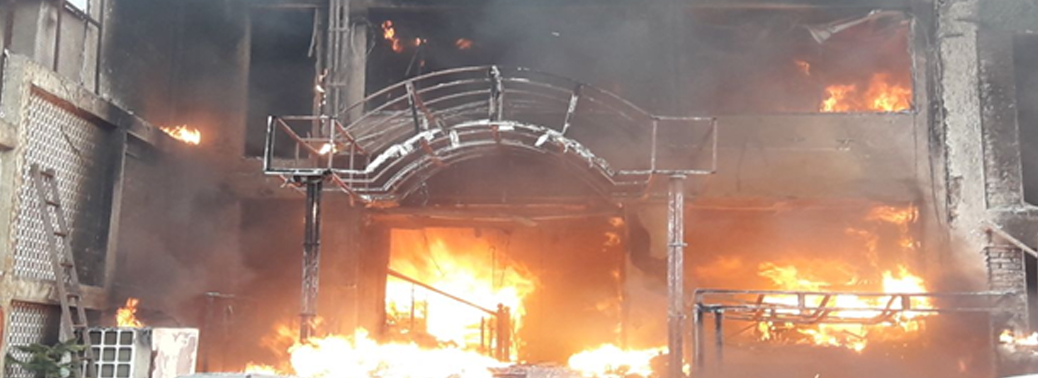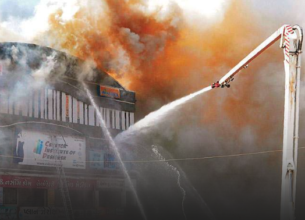FATAL FIRES: THE NEED FOR STRICT SAFETY NORMS
11, Dec 2019

Prelims level : Miscellaneous
Mains level : GS-III Disaster and Disaster Management.
- The Discovery and use of firemay be regarded as the beginning of civilization. Anthropologist Claude Levi-Straus said that ‘primitive people became different From Animals when they started cooking their food’. Not only in cooking, fire was used by them in crafts, in industries and in clearing forests for agriculture and new settlements.
- However, fire also kills people and destroys their possessions.
- Recently, the National Capital witnessed one of the worst fire tragedies in almost two decades when at least 43 people were killed, and several others injured in north Delhi’s Anaj Mandi. Initial enquiries points to many glaring negligence such as locked escape routes, unavailability of fire safety equipment and buildings without the fire safety clearances from the authorities. Rescue operations were also hampered due to narrow lanes.
Fire Safety in India:
- India’s abysmal record on fire safety is reflected in the death of 17,700 people countrywide in fires in both public and residential buildings during 2015, according to the National Crime Records Bureau.
- It should be noted here that the record of rural areas, which remains largely unreported, is no better and on addition will push the figure further up from the estimated total of 20,000 deaths per annum.
- Likewise, the property loss is estimated to be 0.3% of the Gross Domestic Product (GDP).
“Don’t dig well when house is on fire”
- Fire prevention and fire protection is a state subject. The primary responsibility for fire prevention and fire protection lies primarily with State Governments.
- Fire services in India come under the Twelfth Scheduleof the Constitution of India, under the provisions of Article 243W of the Constitution. The performance of the functions listed in the Twelfth Schedule comes under the domain of Municipalities.
The National Building Code (NBC):
- The National Building Code is published by Bureau of Indian Standards. The first edition of the NBC was published in 1970. The third edition of the NBC was published in 2016, incorporating the latest developments in the construction activities in the country.
- The National Building Code (NBC) is the basic model code in India on matters relating to building construction and fire safety. The rules for fire prevention and fire protection are laid in the form of State Regulations or Municipal By-Laws.
Codes and Standards:
- Bureau of Indian Standardshas formulated more than 150 standards on fire safety in buildings and firefighting equipment & systems.
- Oil Industry Safety Directorate(OISD) is a technical directorate under the Ministry of Petroleum and Natural Gas of Government of India. It formulates and coordinates the implementation of a series of self-regulatory measures aimed at enhancing the safety in the oil & gas industry in India.
Fire and laissez-faire:
- According to the India Risks Survey, there has been a 300% increase in fire incidents of commercial buildings in 2014-15. This highlights the gap between India’s dreamy visions of smart cities and the cruel reality of urban chaos.
- Periodically, high-profile cases such as the Uphaar cinema blaze in Delhithat killed 59 people in 1997, and the Kumbakonam school fire in Tamil Nadu in 2004 in which 94 children perished shock the nation, but the issue of fire safety is largely unattended.
- Flouting Fire Safety Norms – Many commercial and residential buildings, have been found flouting fire safety norms. Many occupiers or societies do not bother to conduct regular maintenanceof the fire prevention systems installed in their buildings.
Why does India lag in Fire Safety?
- Prospective Laws– Fire Safety Laws that are framed now are not applicable to the existing buildings, they cannot be implemented retrospectively. For instance, a 100-year old building is not required to obtain fire safety certificate, and the present building codes are not applicable to such buildings.
- Commercial Use– Residential buildings that are considered as low hazard occupancies and are exempted from safety guidelines but being used for commercial purposes increases the risks associated.
- Town Planning – Horizontal and vertical expansion of the cities, without proper planning leads to congestion, which increases the risks.
- Fire Master Plans – Many cities are planned without Fire Protection Masterplans; this makes them vulnerable.
- Citizen Training – Least importance is given to create a knowledged community, which can pro-actively take part in prevention of such incidents. They should at least be trained to operate fire extinguishers and other basic escape precautions.
- Monitoring– Fire safety audits are not conducted properly, due to the unavailability of trained personnel.
- Laxity in following fire safety measures –It was observed that most skyscrapers in Mumbai continue to overlook the fire safety norms compliance certificate. Several prominent high rises in New Delhi are at a high risk of turning into fire traps.
Way Forward:
- Hazard Identification & Risk Assessment (HIRA)can be focused to identify potential hazards.
- A comprehensive fire safety audit can address the inherent fire hazards and recommend measures to reduce the potential fire hazards.
- The fire safety auditwork shall be entrusted to Third Party Agencies, who have expertise in it.
- Training the personnel and creating a well-informed citizenry.
- The State Governmentsshould shed more towards modernization of the fire fighting force.
- Mandating compulsory insurance for all public buildingsagainst fire risk and public liability can bring about a change to the way architects and builders approach the question of safety, since the insurer would require a reduction of risk and compliance with building plans.
- In India, although there are many rules and regulations, codes and standards related to fire safety, these are seldom followed. By 2050, almost 70% of the world’s population will live in cities. India and all countries around the world must see the importance of fire safety when building and extending cities. If not, we will be walking unprepared into a deadly inferno.







